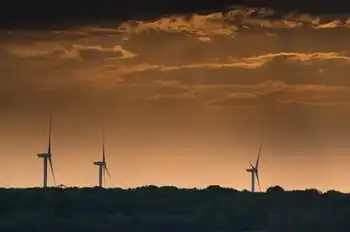Massive power scheme proposed for Montreal
By Calgary Herald
NFPA 70b Training - Electrical Maintenance
Our customized live online or in‑person group training can be delivered to your staff at your location.

- Live Online
- 12 hours Instructor-led
- Group Training Available
The scheme would send an extra 800 cubic metres of water per second through Ottawa — 40 per cent more than the year's average flow rate.
It would flood 1,100 square kilometres of northern Quebec in spring, storing the spring runoff for a gradual release through the year. The goal is to allow $20 billion in annual water sales to the U.S. and more than $1 billion in power sales at home.
It would also deepen the St. Lawrence at the Port of Montreal. Falling water levels there have made the port too shallow for some shipping, at times forcing ships to transfer cargo to trucks in order to get through.
Water levels are already falling through the Great Lakes and St Lawrence, said engineer Pierre Gingras, who wrote the report for the Montreal Economic Institute, a business think-tank.
Bringing in a fresh supply of water would raise the water — at least in the St. Lawrence. And he says bringing this new water would compensate for water exports sent from the upper Great Lakes down the Mississippi River.
"Exporting water is a taboo subject, and it shouldn't be," he said. "It can be done while respecting the environment."
All that northern Quebec runoff today ends up in the Arctic Ocean. "What are you doing with that water now?" he said. "Quebec gets rid of 40,000 cubic metres of fresh water each second."
Gingras says Quebec would need to build six pumping stations to bring water uphill, south along the Bell River, ending up in Val d'Or. From there it would be pumped overland to the upper Ottawa River, which begins in Quebec and flows west to the Ontario border before turning south to Lake Timiskaming.
Gingras is a retired Hydro-Quebec engineer who had a career of dam-building in the huge Manicouagan and La Grande hydroelectric projects. He says that expanding the 11 power dams already on the Ottawa would generate an extra 3,000 megawatts — more than three nuclear reactors' worth of power.
The reports called Northern Waters: A realistic, sustainable and profitable plan to exploit Quebec's blue gold. The Montreal Economic Institute's directors includes economists, business leaders and former federal and provincial politicians.
Its stated goal is to study "how markets function with the aim of identifying the mechanisms and institutions which foster the prosperity and long-term welfare of all the individuals which make up our society."
Environmentalists, meanwhile, have not been persuaded the plan is ecologically benign.
"We must show our disdain for it and remain vigilant to make sure it never gains traction," said John Jackson, a director of Great Lakes United, a Canada-U.S. coalition of residents' groups along the Great Lakes and the rivers that connect them.
He said the added flow could cause erosion, and the spring runoff water is needed in the north, where it floods marshes and other seasonal wetlands.
As well, he worries that expanding the existing power dams along the Ottawa would flood more land.
He also attacked the feasibility of the plan.
"This idea somehow that water backs up, and then you can let more water out at Chicago, the other side of the (Great Lakes) basin — when I first first read the proposal I wondered if it was a satirical piece."
Ottawa Riverkeeper Meredith Brown called the idea "hare-brained."
It would be especially devastating in the upper stretches of the river, where the normal flow is less, she said.
"You've got to go either wider or deeper" to carry more water down a valley. "The problem with going wider is we've developed much of the flood plain areas, particularly in the cities," she said.
Creating new reservoirs also releases mercury from flooded land, making fish too toxic to eat, she said.
Major diversion plans to export water keep coming back, she noted. "Water diversions are still on the table."
Gingras said the Montreal institute's plan has been sent to Hydro-Quebec and the federal and provincial governments, but with no response so far.











